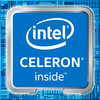Intel Celeron J3355 vs Intel Celeron J3455
Intel Celeron J3355

The Intel Celeron J3355 is a dual-core SoC primarily for inexpensive notebooks and was announced in late 2016. It runs at 2 - 2.5 GHz (Single Core Burst) and is based on the Apollo Lake platform. Similar to the Braswell predecessor, the chip is manufactured in a 14 nm process (P1273) with FinFETs. Besides two CPU cores, the chip also includes a DirectX 12 capable GPU as well as a DDR3L/LPDDR3/LPDDR4 memory controller (dual-channel, up to 1866/2400 MHz).
Architecture
For the first time in a couple of years, Intel completely reworked the CPU architecture of the Atom series. The manufacturer advertises performance gains of roughly 30 percent, but does not reveal any specifics about the individual changes. The new Goldmont architecture should therefore be roughly on par with AMD's Beema/Carrizo-L APUs in terms of per-MHz performance, but it still far behind the more expensive Core CPUs (like Skylake / Kaby Lake).
Performance
The CPU performance of the Celeron J3355 is slightly better than the lower power Celeron N3350 and less depending on the cooling solution. This means the processor is only suited for light daily tasks (office, browsing).
GPU Performance
The HD Graphics 500 (Apollo Lake) is based on Intel's Gen9 architecture, which supports DirectX 12 and is also used for the Kaby Lake / Skylake graphics adapters (like HD Graphics 520). Equipped with 12 EUs and a clock of up to 700 MHz, the performance should be roughly on par with the older HD Graphics (Braswell). This means only older and simpler titles will run smoothly.
The chip also includes an advanced video engine with hardware support for the playback of VP9 and H.265 material (8-bit color-depth).
Power Consumption
The Celeron J3355 is specified at 10 Watt TDP and therefore 4 Watts higher than the slightly slower Celeron N3350.
Intel Celeron J3455
► remove from comparison
The Intel Celeron J3355 is a quad-core SoC primarily for inexpensive notebooks and Mini-PCs and was announced in late 2016. It runs at 1.5 - 2.3 GHz (Single Core Burst) and is based on the Apollo Lake platform. Similar to the Braswell predecessor, the chip is manufactured in a 14 nm process (P1273) with FinFETs. Besides two CPU cores, the chip also includes a DirectX 12 capable GPU as well as a DDR3L/LPDDR3/LPDDR4 memory controller (dual-channel, up to 1866/2400 MHz).
Architecture
For the first time in a couple of years, Intel completely reworked the CPU architecture of the Atom series. The manufacturer advertises performance gains of roughly 30 percent, but does not reveal any specifics about the individual changes. The new Goldmont architecture should therefore be roughly on par with AMD's Beema/Carrizo-L APUs in terms of per-MHz performance, but it still far behind the more expensive Core CPUs (like Skylake / Kaby Lake).
Performance
The CPU performance of the Celeron J3455 is between the mobile Celeron N3450 and Pentium N4200 in the lower range of mobile processors. Therefore, the CPU is best suited for light tasks with not much multitasking (office, browsing).
GPU Performance
The HD Graphics 500 (Apollo Lake) is based on Intel's Gen9 architecture, which supports DirectX 12 and is also used for the Kaby Lake / Skylake graphics adapters (like HD Graphics 520). Equipped with 12 EUs and a clock of up to 750 MHz, the performance should be roughly on par with the older HD Graphics (Braswell). This means only older and simpler titles will run smoothly.
The chip also includes an advanced video engine with hardware support for the playback of VP9 and H.265 material (8-bit color-depth).
Power Consumption
The Celeron J3455 is specified at 10 Watt TDP and therefore 4 Watts higher than the slightly faster Pentium N4200.
| Model | Intel Celeron J3355 | Intel Celeron J3455 | ||||||||||||||||||||||||||||||||
| Series | Intel Celeron | Intel Celeron | ||||||||||||||||||||||||||||||||
| Codename | Apollo Lake | Apollo Lake | ||||||||||||||||||||||||||||||||
| Series: Celeron Apollo Lake |
|
| ||||||||||||||||||||||||||||||||
| Clock | 2000 - 2500 MHz | 1500 - 2300 MHz | ||||||||||||||||||||||||||||||||
| L2 Cache | 2 MB | 2 MB | ||||||||||||||||||||||||||||||||
| Cores / Threads | 2 / 2 | 4 / 4 | ||||||||||||||||||||||||||||||||
| TDP | 10 Watt | 10 Watt | ||||||||||||||||||||||||||||||||
| Technology | 14 nm | 14 nm | ||||||||||||||||||||||||||||||||
| max. Temp. | 105 °C | 105 °C | ||||||||||||||||||||||||||||||||
| Socket | FCBGA1296 | FCBGA1296 | ||||||||||||||||||||||||||||||||
| Features | Intel HD Graphics 500 (12 EUs, 200 - 700 MHz), Quick Sync, AES-NI, max. 8 GB Dual-Channel DDR3L-1866/LPDDR3-1866/LPDDR4-2400 , 8x USB 3.0, 6x PCIe 2.0, 2x SATA 6.0 Gbit/s | Intel HD Graphics 500 (12 EUs, 200 - 750 MHz), Quick Sync, AES-NI, max. 8 GB Dual-Channel DDR3L-1866/LPDDR3-1866/LPDDR4-2400 , 8x USB 3.0, 6x PCIe 2.0, 2x SATA 6.0 Gbit/s | ||||||||||||||||||||||||||||||||
| iGPU | Intel HD Graphics 500 (250 - 700 MHz) | Intel HD Graphics 500 (250 - 750 MHz) | ||||||||||||||||||||||||||||||||
| Architecture | x86 | x86 | ||||||||||||||||||||||||||||||||
| $107 U.S. | $107 U.S. | |||||||||||||||||||||||||||||||||
| Announced | ||||||||||||||||||||||||||||||||||
| Manufacturer | ark.intel.com | ark.intel.com |


 Deutsch
Deutsch English
English Español
Español Français
Français Italiano
Italiano Nederlands
Nederlands Polski
Polski Português
Português Русский
Русский Türkçe
Türkçe Svenska
Svenska Chinese
Chinese Magyar
Magyar